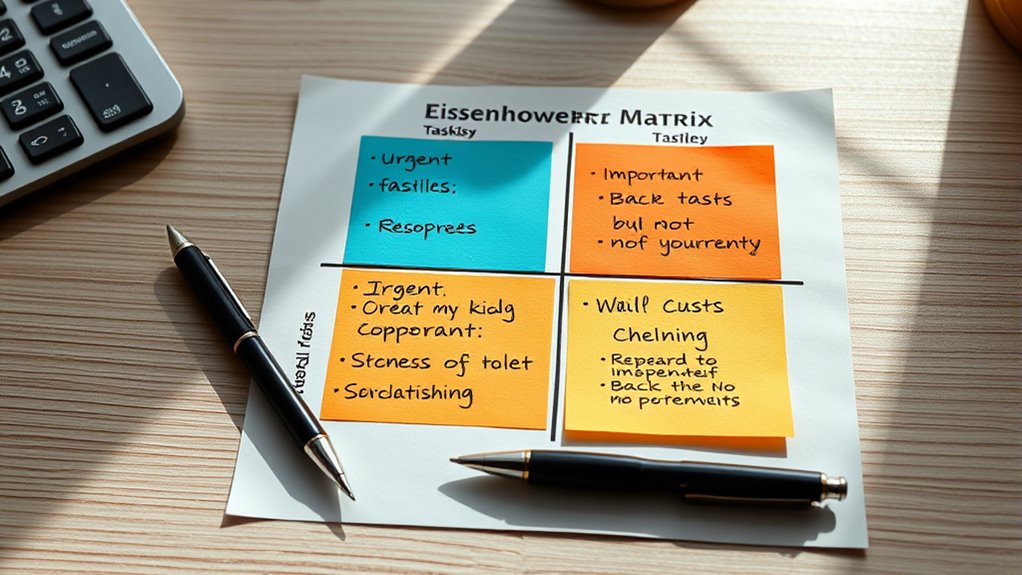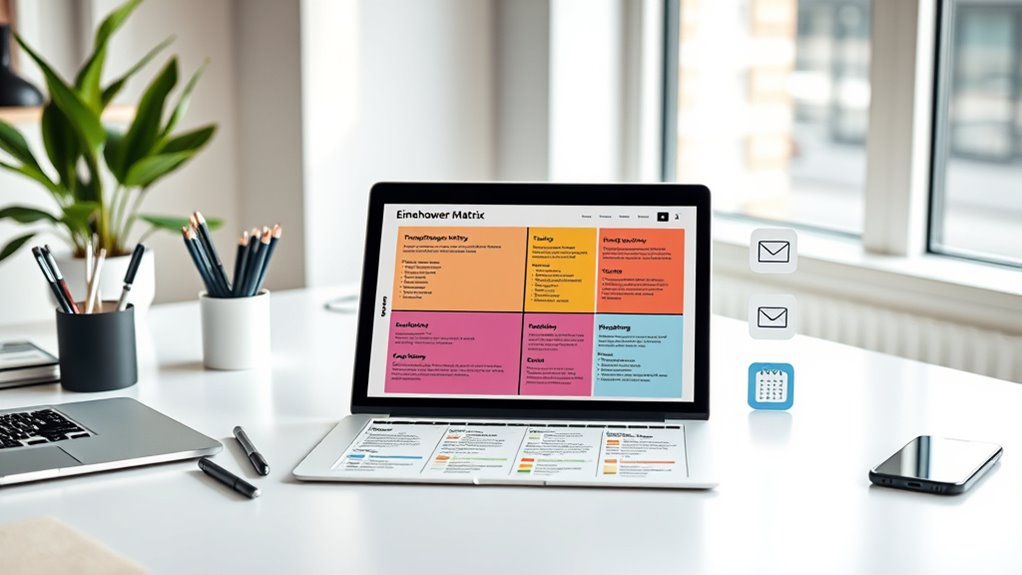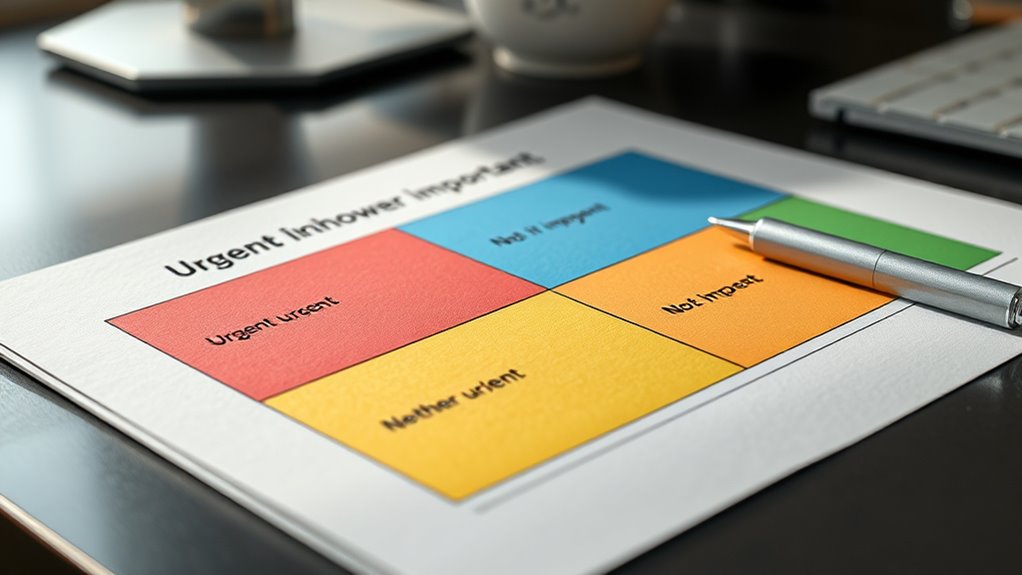To prioritize tasks using the Eisenhower Matrix, start by categorizing each task based on urgency and importance. Focus on completing Quadrant 1 tasks quickly to prevent crises, while dedicating time to Quadrant 2 activities that support your long-term goals. Delegate or schedule less urgent tasks, and limit time spent on low-value activities in Quadrant 4. Mastering these steps helps you stay focused and productive; explore further to optimize your workflow.
Key Takeaways
- Categorize tasks by assessing their urgency and importance to determine the appropriate quadrant for prioritization.
- Focus on completing Quadrant 1 tasks promptly while scheduling dedicated time for Quadrant 2 activities.
- Delegate Quadrant 3 tasks to others to free up time for high-priority activities.
- Limit or eliminate Quadrant 4 activities to reduce distractions and maintain focus on crucial tasks.
- Regularly review and update task priorities to adapt to changing circumstances and ensure alignment with goals.
Understanding the Core Principles of the Eisenhower Matrix

To understand the core principles of the Eisenhower Matrix, it’s essential to recognize that it categorizes tasks based on their urgency and importance. You evaluate each task by asking whether it requires immediate action or can wait, and whether it substantially impacts your goals. This approach helps you avoid spending too much time on trivial, urgent tasks while neglecting important ones that can prevent future crises. The matrix divides tasks into four quadrants, guiding you to focus on what truly matters. By consistently applying this method, you develop a clearer picture of your priorities, enabling better decision-making. The core idea is to shift your focus from reacting to urgent demands to proactively managing important activities that align with your long-term success. Additionally, understanding zodiac compatibility can offer insights into team dynamics and interpersonal relationships that influence your ability to prioritize effectively.
How to Categorize Tasks Effectively Using the Matrix

Effectively categorizing tasks using the Eisenhower Matrix starts with accurately evaluating each task’s urgency and importance. You need to ask yourself whether a task demands immediate action or can wait, and whether it aligns with your long-term goals. For urgent tasks, determine if they truly require immediate attention or if they’re just distractions. For important tasks, assess if they advance your priorities or personal growth. Be honest and specific in this evaluation, avoiding assumptions. Use clear criteria—such as deadlines, consequences, and impact—to assign tasks precisely. Remember, misclassification leads to wasted time or missed opportunities. Regularly review your task list to ensure each item fits the correct quadrant, helping you make better decisions and stay focused on what truly matters. Incorporating prioritization strategies can further enhance your ability to manage tasks effectively.
Strategies for Managing Quadrant 1: Urgent and Important Tasks

When you face urgent and important tasks, you need to act quickly and decisively to prevent last-minute crises. Prioritize these critical tasks to make certain they get completed promptly, reducing stress and potential setbacks. Implement immediate actions to stay on top of urgent issues and maintain control over your workload. Recognizing the divorce process in various states can help you better prepare for legal challenges if needed.
Prioritize Critical Tasks
Prioritizing critical tasks in Quadrant 1 requires a proactive approach to manage urgency without sacrificing quality. You need to act swiftly yet thoughtfully, ensuring urgent tasks are completed efficiently while maintaining standards. Focus on clearly identifying truly critical tasks to avoid wasting time on less impactful issues. Use these strategies:
- Break down complex tasks into manageable steps to prevent feeling overwhelmed.
- Allocate specific time blocks to handle urgent tasks, avoiding disruption to other priorities.
- Limit multitasking to increase accuracy and speed in completing urgent work.
- Regularly review your urgent tasks to confirm their importance before rushing into action.
- Incorporate time management techniques to optimize your handling of urgent and important responsibilities.
Implement Immediate Actions
Managing Quadrant 1 tasks promptly requires implementing immediate actions that balance speed with accuracy. First, assess the task’s urgency and importance quickly, so you can prioritize effectively. Use the “Eat That Frog” technique—tackle the most challenging or high-impact tasks first, preventing procrastination. Stay focused by breaking large tasks into smaller, manageable steps, and set a timer using the Pomodoro method to maintain momentum. Avoid distractions and aim for swift, decisive action to prevent issues from escalating. Delegation is also key; if possible, assign less critical urgent tasks to others to free up your time for what truly demands your attention. Regularly review your progress, adjusting your approach as needed to stay on track and ensure timely completion. Incorporating reviews of educational toys can help identify tools that support efficient learning and development, optimizing your task management strategies.
Planning for Quadrant 2: Long-Term and Strategic Activities

Focusing on Quadrant 2 helps you prioritize long-term goals and strategic activities that prevent urgent crises. Scheduling regular time for these tasks guarantees they don’t get overlooked amid daily demands. By consciously planning these activities, you set yourself up for sustained growth and success. Incorporating long-term planning into your routine ensures that you stay ahead of challenges and capitalize on opportunities for future development.
Prioritizing Long-Term Goals
Have you ever wondered how to guarantee that your long-term goals don’t get lost amid daily urgencies? Prioritizing these goals requires deliberate focus on Quadrant 2 activities. Start by breaking your long-term objectives into smaller, actionable steps that you can schedule regularly. Allocate specific time blocks for strategic planning, skill development, and relationship-building. Regularly review your progress and adjust priorities to stay aligned with your vision. This helps prevent important but not urgent tasks from slipping away. Engaging in Expert advice – My dogs’ names can also provide inspiration for nurturing patience and consistency in your goal-setting process.
Scheduling Strategic Activities
Are you effectively carving out time for your long-term and strategic goals? Scheduling Quadrant 2 activities keeps you focused on growth and future success. Start by identifying key projects that align with your vision. Block dedicated time on your calendar, treating these sessions as non-negotiable appointments. Break down large objectives into manageable tasks and set milestones to track progress. Regularly review your schedule to confirm strategic activities aren’t sidelined by urgent demands. Use specific time slots weekly or monthly for strategic planning, skill development, or relationship building. Remember, consistency is essential. By intentionally reserving time for these high-impact activities, you build momentum toward your goals and prevent them from slipping into the background amidst daily urgencies. Incorporating creating a cozy sanctuary in your workspace can also help foster focus and motivation for these important tasks.
Delegating Tasks in Quadrant 3 to Optimize Workflow

Delegating tasks in Quadrant 3 is essential for maximizing your productivity and keeping your workflow efficient. These tasks are urgent but not important, so passing them on frees you to focus on higher-value activities. You need to identify suitable team members or collaborators capable of handling these tasks effectively. Clear instructions and expectations ensure the delegated work is completed properly and on time. Regular follow-up prevents bottlenecks and maintains accountability. Delegation also empowers your team and develops their skills, creating a more resilient workflow. Remember, effective delegation isn’t just offloading; it’s strategic sharing of workload to optimize overall results. Incorporating tools like the Eye Patch can also serve as a reminder to prioritize self-care and refresh your focus during busy work periods.
Eliminating Distractions: Handling Tasks in Quadrant 4

Why let tasks that are neither urgent nor important clutter your schedule? These Quadrant 4 activities, like mindless browsing or excessive social media, drain your time without adding value. To handle these distractions, first identify them clearly. Set boundaries, such as dedicated times for checking social media or emails, and stick to them. Consider using apps or website blockers to limit access during focused work periods. Cultivate awareness of your habits and replace low-value activities with more meaningful ones, like short breaks, stretching, or quick planning. Regularly evaluate your habits to prevent these tasks from creeping back in. Eliminating these distractions frees up mental space and energy, allowing you to concentrate on tasks that truly matter and enhance your productivity. Additionally, understanding raw food and its benefits can help you make healthier choices and optimize your routines.
Tips for Regularly Reviewing and Updating Your Task Priorities

Regularly reviewing and updating your task priorities keeps you aligned with your evolving goals and prevents clutter from accumulating. Set aside dedicated time weekly or biweekly to reassess your tasks within the Eisenhower Matrix. During these reviews, move tasks between quadrants as urgency and importance shift, and eliminate tasks that no longer serve your objectives. Stay flexible by adjusting deadlines or delegating new urgent tasks. Keep a habit of reflecting on what’s working and what isn’t to refine your approach.
Regularly review tasks to stay aligned, eliminate clutter, and adapt to changing priorities.
- Schedule regular review sessions in your calendar
- Reassess task urgency and importance periodically
- Adjust deadlines and priorities as needed
- Remove or delegate tasks that no longer align with goals
Integrating the Matrix With Other Productivity Tools for Better Results

Integrating the Eisenhower Matrix with other productivity tools can substantially enhance your workflow by providing a more thorough approach to task management. Combining it with project planning tools like Gantt charts or Work Breakdown Structures helps you visualize deadlines and milestones alongside task priorities. Using RACI matrices clarifies who’s responsible for delegated tasks, ensuring accountability. Setting Objectives and Key Results (OKRs) aligns your daily tasks with your long-term goals, making prioritization more strategic. Digital platforms, such as task management apps like Todoist or Asana, allow you to embed the matrix’s quadrants directly into your workflow, enabling real-time updates and tracking. Regularly syncing the matrix with these tools keeps your priorities aligned, streamlines delegation, and guarantees you stay focused on what truly matters.
Frequently Asked Questions
How Can I Adapt the Eisenhower Matrix for Digital Task Management Tools?
You can adapt the Eisenhower Matrix for digital task management by creating custom categories or labels that mirror the four quadrants. Use your app’s tagging system to mark tasks as urgent and important, important but not urgent, delegate, or delete. Set reminders and deadlines for Quadrant 1 and schedule time for Quadrant 2 tasks. Regularly review and update your digital list to stay aligned with your priorities seamlessly.
What Are Common Mistakes to Avoid When Using the Matrix?
You should avoid misclassifying tasks by rushing through the process or overthinking each one. Don’t ignore important but not urgent tasks, as neglecting Quadrant 2 hampers long-term growth. Also, steer clear of cluttering categories with too many tasks, which diminishes clarity. Regularly review and adjust your priorities, and don’t delegate tasks that require your personal input, ensuring the matrix works effectively for your productivity.
How Does the Matrix Help in Balancing Work and Personal Life?
The matrix helps you balance work and personal life by clarifying your priorities. It guarantees you dedicate time to important, long-term goals (Quadrant 2) instead of just urgent tasks. You’ll learn to delegate or eliminate less essential activities, freeing up space for personal growth and relaxation. By regularly reviewing your tasks, you stay aligned with your values and avoid burnout, creating a healthier, more balanced lifestyle.
Can the Eisenhower Matrix Be Used for Team Task Prioritization?
You can definitely use the Eisenhower Matrix for team task prioritization. When you assign tasks to team members, categorize them into quadrants based on urgency and importance. This way, everyone knows what to focus on first and what to delegate or eliminate. It streamlines collaboration, improves efficiency, and guarantees your team tackles high-priority tasks promptly, ultimately boosting productivity and reducing stress across the board.
How Often Should I Reassess and Update Task Categories Within the Matrix?
You should reassess and update your task categories in the Eisenhower Matrix regularly, ideally weekly or biweekly, depending on your workload. This keeps your priorities aligned with changing goals and deadlines. As new tasks come in or priorities shift, review the matrix to re-categorize tasks accordingly. Consistent updates prevent stagnation, guarantee focus on what’s most important, and help you stay productive and organized over time.
Conclusion
By mastering the Eisenhower Matrix, you can boost your productivity and make smarter decisions. Did you know that focusing on Quadrant 2 tasks can increase long-term success by up to 50%? Regularly reviewing your priorities keeps you on track and prevents urgent tasks from overwhelming you. Embrace this method to work smarter, not harder, and watch your efficiency soar—your most important goals are within reach when you prioritize effectively.









